| Republic of Cape Verde República de Cabo Verde | ||||||
|---|---|---|---|---|---|---|
| ||||||
| Anthem: Cântico da Liberdade (Portuguese) Song of Freedom | ||||||
| Capital (and largest city) | Praia 14°55′N 23°31′W / 14.917°N 23.517°W | |||||
| Official language(s) | Portuguese | |||||
| Recognised regional languages | Cape Verdean Creole | |||||
| Demonym | Cape Verdean | |||||
| Government | Parliamentary republic | |||||
| - | President | Pedro Pires | ||||
| - | Prime Minister | José Maria Neves | ||||
| Independence | ||||||
| - | from Portugal | July 5, 1975 | ||||
| Area | ||||||
| - | Total | 4,033 km2 (172nd) 1,557 sq mi | ||||
| - | Water (%) | negligible | ||||
| Population | ||||||
| - | 2010 estimate | 567,000[1] (165th) | ||||
| - | 2009 census | 509,000[2] | ||||
| - | Density | 125.5/km2 (79th) 325.0/sq mi | ||||
| GDP (PPP) | 2010 estimate | |||||
| - | Total | $1.908 billion[3] | ||||
| - | Per capita | $3,647[3] | ||||
| GDP (nominal) | 2010 estimate | |||||
| - | Total | $1.651 billion[3] | ||||
| - | Per capita | $3,156[3] | ||||
| HDI (2010) | ||||||
| Currency | Cape Verdean escudo (CVE) | |||||
| Time zone | CVT (UTC-1) | |||||
| - | Summer (DST) | not observed (UTC-1) | ||||
| Drives on the | right | |||||
| ISO 3166 code | CV | |||||
| Internet TLD | .cv | |||||
| Calling code | +238 | |||||
The Republic of Cape Verde (![]() i /ˌkeɪp ˈvɜrd/; Portuguese: Cabo Verde, pronounced [ˈkabu ˈveɾdɨ]; Kabuverdianu: Kabu Verdi) is an island country, spanning an archipelago of 10 islands located in the central Atlantic Ocean, 570 kilometres off the coast of Western Africa. The islands, covering a combined area of slightly over 4,000 square kilometres (1,500 sq mi), are of volcanic origin and while three of them (Sal, Boa Vista and Maio) are fairly flat, sandy and dry, the remaining ones are generally rockier and have more vegetation. Because of the infrequent occurrence of rainfall the overall landscape is not particularly green, despite what the country's name suggests (verde is Portuguese for "green"). The name of the country stems instead from the nearby Cap Vert, on the Senegalese coast.[5]
i /ˌkeɪp ˈvɜrd/; Portuguese: Cabo Verde, pronounced [ˈkabu ˈveɾdɨ]; Kabuverdianu: Kabu Verdi) is an island country, spanning an archipelago of 10 islands located in the central Atlantic Ocean, 570 kilometres off the coast of Western Africa. The islands, covering a combined area of slightly over 4,000 square kilometres (1,500 sq mi), are of volcanic origin and while three of them (Sal, Boa Vista and Maio) are fairly flat, sandy and dry, the remaining ones are generally rockier and have more vegetation. Because of the infrequent occurrence of rainfall the overall landscape is not particularly green, despite what the country's name suggests (verde is Portuguese for "green"). The name of the country stems instead from the nearby Cap Vert, on the Senegalese coast.[5]
The previously uninhabited islands were discovered and colonized by the Portuguese in the 15th Century, and became an important location in the Atlantic slave trade due to their geographically advantageous position. The islands' prosperity often attracted pirates including Sir Francis Drake, who twice sacked the (then) capital Ribeira Grande, in the 1580s. The islands were also visited by Charles Darwin's expedition in 1832. The decline in the slave trade in the 19th century resulted in an economic crisis. With few natural resources and without strong sustainable investment from the Portuguese, the people grew increasingly discontent with the colonial masters, who nevertheless refused to provide the local authorities with more autonomy. This discontent festered and culminated in 1975, when a movement led by Amílcar Cabral achieved independence for the archipelago.
The country has an estimated population (most of it of creole ethnicity) of about 500,000, with its capital city Praia accounting for a quarter of its citizens. Nearly 38% of the population lives in rural areas according to the 2010 Cape Verdean census; about 20% lives below the poverty threshold,[6] and the literacy rate is around 85%. Politically, the country is a very stable democracy, with notable economic growth and improvements of living conditions despite its lack of natural resources, and has garnered international recognition by other countries and international organizations, which often provide development aid. Since 2007, Cape Verde has been classified as a developing nation.
Tough economic times during the last decades of its colonization and the first years of Cape Verde's independence led many to migrate to Europe, the Americas and other African countries. This migration was so significant that the number of Cape Verdeans and their descendants living abroad currently exceeds the population of Cape Verde itself. Historically, the influx of remittances from these immigrant communities to their families has provided a substantial contribution to help strengthen the country's economy. Currently, the Cape Verdean economy is mostly service-oriented with a growing focus on tourism and foreign investment, which benefits from the islands' warm climate throughout the year, diverse landscape, welcoming people and cultural richness, especially in music.
Contents[hide] |
[edit] History


Before the arrival of Europeans, the Cape Verde Islands were uninhabited. The islands of the Cape Verde archipelago were discovered by Italian and Portuguese navigators around 1456. According to Portuguese official records [7] the first discoveries were made by Genoese born Antonio de Noli, who was afterwards appointed governor of Cape Verde by Portuguese King Afonso V. Other navigators mentioned as contributing with discoveries in the Cape Verde archipelago are Diogo Gomes, Diogo Dias, Diogo Afonso and the Italian Alvise Cadamosto.
In 1462, Portuguese settlers arrived at Santiago and founded a settlement they called Ribeira Grande (now called Cidade Velha, to avoid being confused with the town of Ribeira Grande on the Santo Antão island). Ribeira Grande was the first permanent European settlement in the tropics.[8]
In the 16th century, the archipelago prospered from the transatlantic slave trade.[8] Pirates occasionally attacked the Portuguese settlements. Sir Francis Drake sacked Ribeira Grande in 1585.[8] After a French attack in 1712, the town declined in importance relative to nearby Praia, which became the capital in 1770.[8]
With the decline in the slave trade, Cape Verde's early prosperity slowly vanished. However, the islands' position astride mid-Atlantic shipping lanes made Cape Verde an ideal location for re-supplying ships. Because of its excellent harbour, Mindelo (on the island of São Vicente) became an important commercial centre during the 19th century.[8]
In 1951, Portugal changed Cape Verde's status from a colony to an overseas province in an attempt to blunt growing nationalism. In 1956, Amilcar Cabral, and a group of fellow Cape Verdeans and Guineans organised (in Portuguese Guinea) the clandestine African Party for the Independence of Guinea and Cape Verde (PAIGC), which demanded improvement in economic, social and political conditions in Cape Verde and Portuguese Guinea and formed the basis of the two nations' independence movement. Moving its headquarters to Conakry, Guinea in 1960, the PAIGC began an armed rebellion against Portugal in 1961. Acts of sabotage eventually grew into a war in Portuguese Guinea that pitted 10,000 Soviet bloc-supported PAIGC soldiers against 35,000 Portuguese and African troops.[8]
By 1972, the PAIGC controlled much of Portuguese Guinea despite the presence of the Portuguese troops, but the organization did not attempt to disrupt Portuguese control in Cape Verde. Portuguese Guinea declared independence in 1973 and was granted de jure independence in 1974. Following the April 1974 revolution in Portugal, the PAIGC became an active political movement in Cape Verde. In December 1974, the PAIGC and Portugal signed an agreement providing for a transitional government composed of Portuguese and Cape Verdeans. On June 30, 1975, Cape Verdeans elected a National Assembly which received the instruments of independence from Portugal on July 5, 1975.[8]
Immediately following the November 1980 coup in Guinea-Bissau, relations between Cape Verde and Guinea-Bissau became strained. Cape Verde abandoned its hope for unity with Guinea-Bissau and formed the African Party for the Independence of Cape Verde (PAICV). Problems have since been resolved and relations between the countries are good. The PAICV and its predecessor established a one-party system and ruled Cape Verde from independence until 1990.[8]
Responding to growing pressure for pluralistic democracy, the PAICV called an emergency congress in February 1990 to discuss proposed constitutional changes to end one-party rule. Opposition groups came together to form the Movement for Democracy (MPD) in Praia in April 1990. Together, they campaigned for the right to contest the presidential election scheduled for December 1990.
The one-party state was abolished September 28, 1990, and the first multi-party elections were held in January 1991. The MPD won a majority of the seats in the National Assembly, and MPD presidential candidate António Mascarenhas Monteiro defeated the PAICV's candidate with 73.5% of the votes. Legislative elections in December 1995 increased the MPD majority in the National Assembly. The party won 50 of the National Assembly's 72 seats.
A February 1996 presidential election returned President Monteiro to office. Legislative elections in January 2001 returned power to the PAICV, with the PAICV holding 40 of the National Assembly seats, MPD 30, and Party for Democratic Convergence (PCD) and Party for Labor and Solidarity (PTS) 1 each. In February 2001, the PAICV-supported presidential candidate Pedro Pires defeated former MPD leader Carlos Veiga by only 13 votes.[8]
[edit] Geography
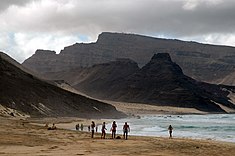 | ||||||||||||||||||||||||||||||||||||||||||||||||||||||||||||
|---|---|---|---|---|---|---|---|---|---|---|---|---|---|---|---|---|---|---|---|---|---|---|---|---|---|---|---|---|---|---|---|---|---|---|---|---|---|---|---|---|---|---|---|---|---|---|---|---|---|---|---|---|---|---|---|---|---|---|---|---|
| | ||||||||||||||||||||||||||||||||||||||||||||||||||||||||||||
| ||||||||||||||||||||||||||||||||||||||||||||||||||||||||||||
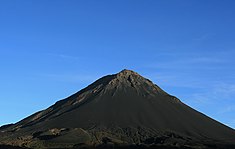

The Cape Verde archipelago is located in the Atlantic Ocean, approximately 570 kilometres (350 mi) off the coast of West Africa, near Mauritania and Senegal, and is part of the Macaronesia ecoregion. It lies between latitudes 14° and 18°N, and longitudes 22° and 26°W.
The country is a horseshoe-shaped cluster of ten islands (nine inhabited) and eight islets,[10] that constitute an area of 4033 km².[10]
The islands are spatially divided into two groups:
- The Ilhas de Barlavento (English: windward islands): Santo Antão, São Vicente, Santa Luzia, São Nicolau, Sal, Boa Vista;[10] and
- The Ilhas de Sotavento (English: leeward islands): Maio, Santiago, Fogo, Brava.[10]
The largest island, both in size and population, is Santiago, which hosts the nation's capital, Praia, the principal agglomeration in the archipelago.[10]
[edit] Physical geography
Magnetic anomalies identified in the vicinity of the archipelago indicates that the structures forming the islands date back 125-150 million years: the islands themselves date from 8 million (in the west) to 20 million years (in the east).[11] The oldest exposed rocks occurred on Maio and northern peninsula of Santiago and are 128-131 million year old pillow lavas. The first stage of volcanism in the islands began in the early Miocene, and reached its peak at the end of this period, when the islands reached their maximum sizes. Historical volcanism (within human settlement) has been restricted to the island of Fogo.
The origin of the islands' volcanism has been attributed to a hotspot, associated with bathymetric swell that formed the Cape Verde Rise.[12] The Rise is one of the largest protuberances in the world's oceans, rising 2.2 kilometers in a semi-circular region of 1200 km², associated with a rise of the geoid and elevated surface heat flow.[11]
Though Cape Verde's islands are all volcanic in origin, they vary widely in terrain.[10]
Most recently erupting in 1995, Pico do Fogo is the largest active volcano in the region. It has a 8 km (5 mi) diameter caldera, whose rim is 1,600 m (5,249 ft) altitude and an interior cone that rises to 2,829 m (9,281 ft) above sea level. The caldera resulted from subsidence, following the partial evacuation (eruption) of the magma chamber, along a cylindrical column from within magma chamber (at a depth of 8 km (5 mi)).
Geologically, the islands are principally composed of igneous rocks, with volcanic structures and pyroclastic debris comprising the majority of the archipelago's total volume. The volcanic and plutonic rocks are distinctly basic; the archipelago is a soda-alkaline petrographic province, with a petrologic succession which is similar to that found in other Macaronesian islands.
Extensive salt flats are found on Sal and Maio.[10] On Santiago, Santo Antão, and São Nicolau, arid slopes give way in places to sugarcane fields or banana plantations spread along the base of towering mountains.[10]
[edit] Climate
Cape Verde's climate is milder than that of the African mainland; because the island is surrounded by the sea, temperatures are generally moderate.[10] Average daily high temperatures range from 25 °C (77 °F) in January to 29 °C (84.2 °F) in September.[9] Cape Verde is part of the Sahelian arid belt, with nothing like the rainfall levels of nearby West Africa.[10] It does rain irregularly between August and October, with frequent brief-but-heavy downpours.[10] A desert is usually defined as terrain which receives less than 250 mm (9.8 in) of annual rainfall. Cape Verde's total (261 mm/10.3 in) is slightly above this criterion, which makes the area climate semi-desert.
Hurricanes that form near the Cape Verde Islands are sometimes referred to as Cape Verde-type hurricanes. These hurricanes can become very intense as they cross warm Atlantic waters.
[edit] Biome
Cape Verde's isolation has resulted in the islands having a number of endemic species, particularly bird and reptiles, many of which are endangered by human development. Endemic birds include Alexander's Swift (Apus alexandri), Bourne's Heron (Ardea purpurea bournei), the Raso Lark (Alauda razae), the Cape Verde Warbler (Acrocephalus brevipennis), and the Iago Sparrow (Passer iagoensis).[13] The islands are also an important breeding area for seabirds including the Cape Verde Shearwater. Reptiles include the Cape Verde Giant Gecko (Tarentola gigas).
[edit] Human geography
Cape Verde is divided into 22 municipalities (concelhos) and subdivided into 32 parishes (freguesias), based on the religious parishes that existed during the colonial period:


[edit] Demographics
Most of the population is of creole ethnicity, mixed from black African and European descent. The European men who colonized Cape Verde did not usually bring wives or families with them. As female African slaves were brought to the islands inter-marriages occurred.[10]
A genetic study revealed that the ancestry of the population in Cape Verde is 57% African and 43% European.[14]
Around 95% of the population is Christian (more than 85 percent of the population is nominally Roman Catholic,[15] though for a minority of the population Catholicism is syncretized with African influences).[2] The largest Protestant denomination is the Church of the Nazarene; other groups include the Seventh-day Adventist Church, the Church of Jesus Christ of Latter-day Saints, the Assemblies of God, the Universal Church of the Kingdom of God, and various other Pentecostal and evangelical groups.)[15] There are small Baha'i communities and a small Muslim community.[15] The number of atheists is estimated at less than 1 percent of the population.[15]
Cape Verde's official language is Portuguese. It is the language of instruction and government. However, the Cape Verdean Creole is used colloquially and is the mother tongue of virtually all Cape Verdeans. Cape Verdean Creole or Kriolu is a dialect continuum of a Portuguese-based creole, which varies from island to island. There is a substantial body of literature in Creole, especially in the Santiago Creole and the São Vicente Creole. Creole has been gaining prestige since the nation's independence from Portugal. However, the differences between the varied forms of the language within the islands have been a major obstacle in the way of standardization of the language. Some people have advocated the development of two standards: a North (Barlavento) standard, centered on the São Vicente Creole, and a South (Sotavento) standard, centered on the Santiago Creole. Manuel Veiga, PhD, a linguist by training, and Minister of Culture of Cape Verde, is the premier proponent of Kriolu's officialization and standardization. The demographic statistics site ESA says Cape Verde has a population of 567,000 in 2010.
[edit] Emigration

Today, more Cape Verdeans live abroad than in Cape Verde itself, with significant emigrant[16] Cape Verdean communities in the United States (500,000 Cape Verdeans descent, with a major concentration on the New England coast from Providence, Rhode Island, to Boston, Massachusetts). There are also significant Cape Verde populations in Portugal (150,000), Angola (45,000), São Tomé and Príncipe (25,000), Senegal (25,000), the Netherlands (20,000, of which 15,000 are concentrated in Rotterdam), France (25,000), Scandinavia (7,000), Italy (10,000) and Spain (12,500). There is also a Cape Verdean community in Argentina numbering 8,000. A large number of Cape Verdeans and people of Cape Verdean descent that immigrated before 1975 are not included in these statistics, because all the Cape Verdeans had Portuguese passports before 1975.
There are approximately 2,000 Chinese immigrants in Cape Verde, as well as citizens of the African mainland (most of these immigrants hail from West Africa), there are also a significant number of citizens of Europe and South America (Brazil) residing in the country. There are an estimated 12,500 legal immigrants in Cape Verde.
In the USA, the children and grandchildren of the first immigrant waves became involved in the Civil Rights movement of the 1960s. This led them to make links with other US black groups. Cape-Verdean Americans have also been involved in the US Army for centuries; in the Revolutionary War, Civil War, the First and Second World Wars, as well as the Korean and Vietnam Wars.[17] Cape Verdeans moved to places all over the world, from Macau to Haiti to Argentina to northern Europe.[18]
[edit] Politics
Cape Verde is a stable representative Parliamentary republic.[19] The constitution —adopted in 1980 and revised in 1992, 1995 and 1999— defines the basic principles of its government. The president is the head of state and is elected by popular vote for a 5-year term. The prime minister is the head of government and proposes other ministers and secretaries of state. The prime minister is nominated by the National Assembly and appointed by the president. Members of the National Assembly are elected by popular vote for 5-year terms. Three parties now hold seats in the National Assembly—PAICV 40, MPD 30, and Cape Verdean Independent Democratic Union (UCID) 2.[8]
The judicial system consists of a Supreme Court of Justice — whose members are appointed by the president, the National Assembly, and the Board of the Judiciary — and regional courts. Separate courts hear civil, constitutional, and criminal cases. Appeal is to the Supreme Court.[8]
Cape Verde follows a policy of nonalignment and seeks cooperative relations with all friendly states.[8] Angola, Brazil, the People's Republic of China, Cuba, France, Germany, Portugal, Spain, Senegal, Russia and the United States maintain embassies in Praia.[8] Cape Verde is actively interested in foreign affairs, especially in Africa.[8] It has bilateral relations with some Lusophone nations and holds membership in a number of international organisations.[8] It also participates in most international conferences on economic and political issues.[8] Cape Verde has a Special Partnership status[20] with the EU and might apply for membership.[21]
The military of Cape Verde consists of a coast guard and an army; 0.7% of the country's GDP was spent on the military in 2005.
[edit] International recognition
Cape Verde is often praised as an example among African nations, for its stability and developmental growth despite its lack of natural resources. Among others, it has been recognized with the following assessments:
| Index | Score | PALOP rank | CPLP rank | African rank | World rank | Year |
|---|---|---|---|---|---|---|
| Human Development Index | 0.534 | 1 | 3 | 11 | 118 | 2010 |
| Ibrahim Index of African Governance | 75.5 | 1 | N/A | 4 | N/A | 2010[22] |
| Freedom of the Press | 28 (Free) | 1 | 2 | 4 | 60 | 2009 |
| Freedom in the World | 1/1[note 1] | 1 | 1[note 2] | 1[note 3] | 1[note 4] | 2010 |
| Press Freedom Index | 8 | 1 | 1 | 2 | 26 | 2010 |
| Democracy Index | 7.94 (Flawed democracy) | 1 | 2 | 2 | 27 | 2010 |
| Corruption Perceptions Index | 5.1 | 1 | 2 | 3 | 45 | 2010 |
| Index of Economic Freedom[23] | 64.6 | 1 | 1 | 3 | 65 | 2010 |
| e-Government Readiness Index | 0.4054 | 1 | 3 | 6 | 108 | 2010 |
| Failed States Index | 77.2 | 2 | 3 | 14 | 89[note 5] | 2010 |
Legend:
| Top 3 | Top 10 | Other |
- ^ 1/1 is the highest possible rating.
- ^ With the maximum score, Cape Verde shares the first place with Portugal.
- ^ Cape Verde was the only African country to reach the maximum rating.
- ^ With the maximum score, Cape Verde shares the first place with 48 other countries.
- ^ The rank on this list is expressed in reverse order. To be comparable with the other rankings on this table, the actual rank of 88 was inverted, by subtracting it from the number of countries on the list, currently 177.
[edit] Economy
Cape Verde has few natural resources, scant rainfall and limited supplies of fresh water.[24] Only 4 of the 10 main islands (Santiago, Santo Antão, Fogo, and Brava) normally support significant agricultural production,[25] and over 90% of all food consumed in Cape Verde is imported. Mineral resources include salt, pozzolana (a volcanic rock used in cement production), and limestone.[8] Its small number of wineries making Portuguese-style wines have traditionally focused on the domestic market, but have recently met with some international acclaim. A number of wine tours of Cape Verde's various microclimates began to be offered in spring 2010 and can be arranged through the tourism office.[26]
The economy of Cape Verde is service-oriented, with commerce, transport, and public services accounting for more than 70% of GDP.[citation needed] Although nearly 38% of the population lives in rural areas, agriculture and fishing contribute only about 9% of GDP. Light manufacturing accounts for most of the remainder. Fish and shellfish are plentiful, and small quantities are exported. Cape Verde has cold storage and freezing facilities and fish processing plants in Mindelo, Praia, and on Sal. Expatriate Cape Verdeans contribute an amount estimated at about 20% of GDP to the domestic economy through remittances.[8]
Since 1991, the government has pursued market-oriented economic policies, including an open welcome to foreign investors and a far-reaching privatization programme. It established as top development priorities the promotion of a market economy and of the private sector; the development of tourism, light manufacturing industries, and fisheries; and the development of transport, communications, and energy facilities. From 1994 to 2000 about $407 million in foreign investments were made or planned, of which 58% were in tourism,[27] 17% in industry, 4% in infrastructure, and 21% in fisheries and services.[8]
Between 2000 and 2009, real GDP increased on average by over 7 percent a year, well above the average for Sub-Saharan countries and faster than most small island economies in the region. Strong economic performance was bolstered by one of the fastest growing tourism industry in the world, as well as by substantial capital inflows that allowed Cape Verde to build up national currency reserves to the current 3.5 months of imports. Unemployment has been falling rapidly, and the country is on track to achieve most of the UN Millenium Development Goals – including halving its 1990 poverty level. In 2007, Cape Verde joined the WTO and in 2008 the country graduated from Least Developed Country (LDC) to Middle Income Country (MIC) status.[28]
Cape Verde has significant cooperation with Portugal at every level of the economy, which has led it to link its currency first to the Portuguese escudo and, in 1999, to the euro. On June 23, 2008 Cape Verde became the 153rd member of the WTO.[29]
[edit] Development
The European Commission's total allocation for the period of 2008–2013 foreseen for Cape Verde to address "poverty reduction, in particular in rural and periurban areas where women are heading the households, as well as good governance" amounts to €54.1 million.[30]
[edit] Wildlife
[edit] Tourism

Cape Verde's strategic location at the crossroads of mid-Atlantic air and sea lanes has been enhanced by significant improvements at Mindelo's harbor (Porto Grande) and at Sal's and Praia's international airports. A new international airport was opened in Boa Vista in December 2007, and on the island of Sao Vicente, the newest international airport (Sao Pedro Airport) in Cape Verde, was opened in late 2009. Ship repair facilities at Mindelo were opened in 1983. The major ports are Mindelo and Praia, but all other islands have smaller port facilities. In addition to the international airport on Sal, airports have been built on all of the inhabited islands. All but the airport on Brava enjoy scheduled air service. The archipelago has 3,050 km (1,895 mi) of roads, of which 1,010 km (628 mi) are paved, most using cobblestone.[8]
The country's future economic prospects depend heavily on the maintenance of aid flows, the encouragement of tourism, remittances, outsourcing labor to neighboring African countries, and the momentum of the government's development program.[8]
Tourism has increased in recent years. Large hotels have been built across the country in an effort to boost tourism. In particular, on the islands of Boa Vista (Club Hotel Riu Karamboa (750 rooms)), and Sal (Club Hotel Riu Funana/Garopa (1000 rooms)--the largest hotel in all of West Africa). The Cape Verde islands have a relatively low crime rate and beautiful beaches, as well as having engaging local people. Tourists and leisure seekers from across Europe and the world are coming to the country in larger numbers.
In 2010, about 382,000 tourists visited the archipelago.
[edit] Culture

Cape Verdean social and cultural patterns are similar to those of rural Portugal and Africa.[10] Soccer (Futebol) games and church activities are typical sources of social interaction and entertainment.[10] The traditional walk around the praça (town square) to meet friends is practiced regularly in Cape Verde towns.[10] In towns with electricity, television is available on two channels (Cape Verdean and Portuguese).[10]
Cape Verde music incorporates Portuguese, Caribbean, African, and Brazilian influences.[31] Cape Verde's quintessential national music is the morna, a melancholy and lyrical song form typically sung in Cape Verdean Creole. The most popular music genre after morna is the coladeira followed by funaná and batuque music. Amongst the most worldwide known Cape Verdean singers, are the singers Ildo Lobo and Cesaria Evora whose songs became a hallmark of the country and its culture. There are also well known artists born to Cape Verdean parents who excelled themselves. Amongst these artists are jazz pianist Horace Silver, Duke Ellington's saxophonist Paul Gonsalves and singer Lura.
Dance forms include the soft dance morna, the extreme sensuality of coladeira including the modernized version called passada (zouk), the Funaná (a sensual mixed Portuguese and African dance), and the Batuque dance.
Cape Verdean literature is one of the richest of Lusophone Africa. Famous poets include Paulino Vieira, Manuel de Novas, Sergio Frusoni, Eugénio Tavares, and B. Léza, and famous authors include Baltasar Lopes da Silva, António Aurélio Gonçalves, Manuel Lopes, Orlanda Amarílis, Henrique Teixeira de Sousa, and Germano Almeida.
The Cape Verde diet is mostly based on fish and staple foods like corn and rice. Vegetables available during most of the year are potatoes, onions, tomatoes, manioc, cabbage, kale, and dried beans. Fruits like banana and papayas are available year-round, while others like mangos and avocados are seasonal.[10] A popular dish served in Cape Verde is Cachupa.
[edit] Health and education
[edit] Health
The infant mortality rate in Cape Verde is 21 per 1,000. The AIDS prevalence rate is 0.5%, the literacy rate is 85, and 98.9% among Cape Verdean youth. Life expectancy in Cape Verde is 70 years for males and 75 years for females according to the UN. [32] Cape Verde has been steadily developing[33] since its independence, and besides having been promoted to the group of "medium development" countries in 2007, leaving the Least Developed Countries category (which is only the second time it has happened to a country[34]), is currently the 12th best ranked country in Africa in terms of Human Development Index
[edit] Education
Primary school education in Cape Verde is mandatory between the ages of 6 and 14 years and free for children ages 6 to 12.[35] In 2008, the net enrollment ratio for primary school was 84%.[36] While enrollment rates indicate a level of commitment to education, they do not always reflect children's participation in school.[35] Textbooks have been made available to 90 percent of school children, and 83 percent of the teachers have attended in-service teacher training.[35] Although most children have access to education, some problems remain.[35] For example, many students and some teachers speak Creole at home and have a poor command of Portuguese (the language of instruction); there is insufficient spending on school materials, lunches, and books; and there is a high repetition rate for certain grades.[35]
[edit] Soccer
Although the Cape Verde national football team represents Cape Verde abroad, many internationally known soccer players were born in Cape Verde, or were descendants of Cape Verdeans, and play for other nation's teams. Several currently play, or have played, in the Portuguese league or national team, such as Nani, Jorge Andrade or Nélson Marcos. Henrik Larsson (whose father is Cape Verdean) played for Sweden, Patrick Vieira (whose mother is Cape Verdean) plays for France, while Gelson Fernandes (who was born in Praia) plays for Switzerland.
[edit] Windsurfing
Cape Verde is famous for wavesailing (a type of windsurfing). Josh Angulo, a Hawaiian and 2009 PWA Wave World Champion, has done much to promote the archipelago as a windsurfing destination. Cape Verde is now his adopted country.
[edit] See also(copy of wikipedia)
| Find more about Cape Verde on Wikipedia's sister projects: | |
| Images and media from Commons | |
| News stories from Wikinews | |
| Source texts from Wikisource | |



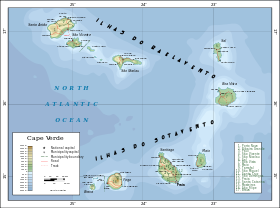



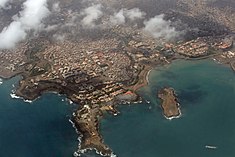





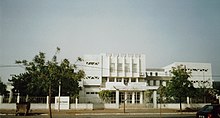
No comments:
Post a Comment